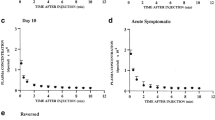Summary
The effects of potential toxins of hepatic coma on the blood-brain barrier (BBB) permeability of the rat have been examined using the Oldendorf technique. Classical toxins of hepatic failure such as ammonia, methyl octanoate, mercaptans, and phenol caused significant increases in BBB permeability. A slight increase in permeability occurred following infusion of peroxidized linoleic acid and unconjugated bilirubin but no increase after infusion of bile acids.E. coli endotoxin infused into rats following partial hepatectomy also increased the BBB permeability.
Similar content being viewed by others
References
Bron, B., Waldram, R., Silk, D.B., and Williams, R., Serum, cerebrospinal and brain levels of bile acids in patients with fulminant hepatic failure. Gut18 (1977) 692–696.
Brunner, G., Windus, G., and Losgen, H., On the role of free phenols in the blood of patients in hepatic failure, in: Artificial Liver Support, pp. 25–31. Eds G. Brunner and F.W. Schmidt. Springer, Berlin/Heidelberg/New York 1981.
Canalese, J., Gove, C.D., Gimson, A.E.S., Wilkinson, S.P., Wardle, E.N., and Williams, R., Reticuloendothelial system and hepatocyte function in fulminant hepatic failure. Gut23 (1982) 265–269.
Chen, S., Mahaderan V. and Zieve, L., Volatile fatty acids in the breath of patients with cirrhosis of the liver. J. Lab. clin. Med.75 (1970) 622–627.
Dahl, D.R., Short chain fatty acid inhibition of rat brain Na−K adenosine triphostphatase. J. Neurochem.15 (1968) 815–820.
Flannery, D.B., Hsia, E., and Wolf, B., Current status of hyperammonemic syndromes. Hepatology2 (1982) 495–506.
Foster, D., Ahmed, K., and Zieve, L., Action of methanethiol on Na+/K+ ATPase: implications for hepatic coma. Ann. N.Y. Acad. Sci.242 (1974) 573–576.
Gutteridge, J.M.C., and Wardle, E.N., Peroxidation of liver and brain tissue of paracetamol poisoned rats. Med. Lab. Sci.38 (1981) 167–169.
Higgins, G.M., and Anderson, R.M., Restoration of the liver of the white rat following partial surgical removal. Archs Path.12 (1931) 186–202.
James, J.H., Ziparo, V., Jeppson, B., and Fischer, J.E., Hyperammonaemia, plasma amino acid imbalance, and blood-brain amino acid transport: a unified theory of portalsystemic encephalopathy. Lancet2 (1979) 772–775.
Lai, J.C.K., Silk, D.B., and Williams, R., Plasma short-chain acids in fulminant heptic failure. Clinica chim. Acta78 (1977) 305–310.
Levine, R.L., Fredericks, A.B., and Rapoport, S.I., Entry of bilirubin into the brain due to opening of the blood-brain barrier. Pediatrics69 (1982) 255–259.
Livingstone, A.S., Goresky, C.A., Finlayson, M.H., and Hinchey, E.J., Changes in the blood-brain barrier in hepatic coma after hepatectomy in the rat. Gastroenterology73 (1977) 697–704.
Matsumoto, J., The convulsive mechanism of phenol derivatives. Med. J. Osaka Univ.13 (1963) 313–323.
McKhann, G.M., and Tower, D.B., Ammonia toxicity and cerebral oxidative metabolism. Am. J. Physiol.200 (1961) 420–427.
Oldendorf, W.H., Measurement of brain uptake of radio-labelled substances using a tritiated water internal standard. Brain Res.24 (1970) 372–376.
Pardridge, W.M., Connor, J.D., and Crawford, I.L., Permeability changes in the blood-brain barrier: Causes and consequences. CRC Crit. Rev. Toxic.3 (1975) 159–99.
Rozdilsky, B., and Olszewski, J., Experimental study of the toxicity of bilirubin in newborn animals. J. Neuropath. exp. Neurol.20 (1961) 193.
Wardle, E.N., Phenols, phenolic acids and sodium-potassium ATPase. J. molec. Med.3 (1978) 319–327.
Wood, C.B., Karran, S.J., and Blumgart, L.H., Metabolic changes following varying degrees of partial hepatectomy in the rat. Br. J. Surg.60 (1973) 613–617.
Zieve, L., Doizaki, W.M., and Zieve, F.J., Synergism between mercaptans and ammonia or fatty acids in the production of coma: a possible role for mercaptans in the pathogenesis of hepatic coma. J. Lab. clin. Med.83 (1974) 16–28.
Zieve, L., Synergism among toxic factors and other endogenous abnormalities in hepatic encephalopathy, in: Artificial Liver Support, pp. 18–24. Eds G. Brunner and F.W. Schmidt. Springer, Berlin/Heidelberg/New York 1981.
Author information
Authors and Affiliations
Rights and permissions
About this article
Cite this article
Zaki, A.E.O., Wardle, E.N., Canalese, J. et al. Potential toxins of acute liver failure and their effects on blood-brain barrier permeability. Experientia 39, 988–991 (1983). https://doi.org/10.1007/BF01989765
Published:
Issue Date:
DOI: https://doi.org/10.1007/BF01989765




